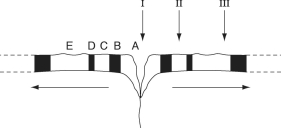The following questions refer to the description and figure below.
The figure represents a cross section of the sea floor through a mid-ocean rift valley, with alternating patches of black and white indicating sea floor with reversed magnetic polarities. At the arrow labeled "I" (the rift valley) , the igneous rock of the sea floor is so young that it can be accurately dated using carbon-14 dating. At the arrow labeled "III," however, the igneous rock is about 1 million years old, and potassium-40 dating is typically used to date such rocks. NOTE: the dashed horizontal arrows indicate the direction of sea-floor spreading, away from the rift valley.
 Figure 25.1
Figure 25.1
-Let's say that a hypothetical submersible robot was used to collect samples of sedimentary rock from the sea floor along the section illustrated. The robot moved back and forth along the transect, collecting first from site A, then site III, then site B, then site II, and lastly site D. Assuming that sedimentation has occurred at a constant rate along the transect over the past million years, rearrange the sites mentioned above on the basis of the thickness of the sediments overlying the igneous rock, from thickest to thinnest.
Definitions:
Statute
A written law passed by a legislative body at the federal or state level, setting forth regulations, provisions, and penalties.
Common Law
A legal system based on custom and court rulings rather than written laws, primarily in English-speaking countries.
Cell Phone Usage
The rules or guidelines governing the use of mobile phones in various contexts, such as driving or in certain public spaces.
Purposes of Law
The objectives that laws are designed to achieve, including maintaining social order, protecting individual rights, resolving disputes, and promoting social justice.
Q6: Gap genes and pair-rule genes fall into
Q21: The term "homoplasy" is most applicable to
Q34: The thermoacidophile, Sulfolobus acidocaldarius lacks peptidoglycan. What
Q35: A gelatinous seaweed that grows in shallow,
Q40: The dispersal and/or nurture of young after
Q53: In seedcracker finches from Cameroon, small- and
Q54: Typically, mutations that modify the active
Q69: If the complex protein assemblage of the
Q69: Scientists developed a set of guidelines to
Q87: The various taxonomic levels (viz, genera, classes,